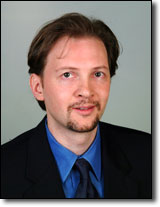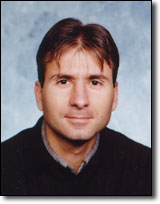
2005 IEEE International Conference on Acoustics, Speech, and Signal Processing
March 18-23, 2005 • Pennsylvania Convention Center/Marriott Hotel • Philadelphia, PA, USA
ICASSP
30th Anniversary
Tutorial TUT-2: MIMO systems for wireless communications
Instructors
C. Papadias; Lucent Technologies
A. Lozano; Lucent Technologies
Time & Location
Friday, March 18, 14:00 - 17:00, Location: CC: Room 111
Abstract
Multiple-Input / Multiple Output (MIMO) technology has emerged in the last decade as a powerful means of increasing the throughput and performance of wireless communication systems. Research on this relatively new technology has penetrated in a substantial way many fields, ranging from signal processing to information / communication theory to wireless propagation. Equally importantly, MIMO technology has made its way into current and next generation communication standards and systems. In this tutorial, we will provide an overview of MIMO systems, starting with the fundamentals of capacity, random channels, basic transceiver architectures, diversity, space-time coding and channel estimation. We will then review some more recent results in the areas of diversity vs. multiplexing trade-offs, input optimization / precoding, fundamental limits of coherent operation and multi-user MIMO, including systems with interference. Finally we will cover certain applications of MIMO techniques in current wireless systems.
Course requisites: This course is addressed to both entry-level students / engineers / researchers as well as the generally knowledgeable individual in the field. A basic understanding of communication system fundamentals is presumed. The tutorial is structured so as to progress gradually from basic concepts onto some more recent / advanced findings. Some example applications are mentioned towards the end, in an attempt to link the theory to current and emerging wireless systems.
Course Outline:
- MIMO Basics
- Definitions
- Mutual information of deterministic MIMO channels
- Ergodic capacity, outage capacity and delay-limited capacity
- Examples and special cases
- Capacity of random i.i.d. Rayleigh fading MIMO channels
- With channel state information (CSI) at the transmitter
- Without CSI at the transmitter
- Basic transceiver architectures:
- V-BLAST
- D-BLAST
- Space-time coding basics
- The concept of diversity
- Space-time block coding
- Space-time trellis coding
- Advanced topics
- Diversity vs. multiplexing trade-offs
- Input optimization (precoding)
- Capacity-achieving input optimization
- Minimum Mean Squared Error (MMSE) input optimization
- Limits of non-coherent operation
- Multi-user MIMO
- Multiple Access channel
- Broadcast channel
- MIMO systems with interference
- Applications
- Cellular
- Transmit diversity for circuit-switched traffic
- Spatial Multiplexing for 3G packet data
- Wireless LANs
- Interference mitigation in MIMO OFDM systems
Presenter Information

Constantinos Papadias was born in Athens, Greece, in 1969. He received the diploma of electrical engineering from the National Technical University of Athens (NTUA) in 1991 and the Ph.D. degree in signal processing (highest honors) from the Ecole Nationale Supérieure des Télécommunications (ENST), Paris, France, in 1995. From 1992 to 1995, he was Teaching and Research Assistant at the Mobile Communications Department, Eurécom, France. In 1995, he joined the Information Systems Laboratory, Stanford University, Stanford, CA, as PostDoctoral Researcher, working in the Smart Antennas Research Group. In November 1997 he joined the Wireless Research Laboratory of Bell Labs, Lucent Technologies, Holmdel, NJ, as Member of Technical Staff and was later promoted to Technical Manager. He has authored several papers, patents and standards contributions and he received the IEEE Signal Processing Society’s 2003 Young Author Best Paper Award. He participates in several research projects within the European Commission’s Information Society Technologies (IST) program and represents Lucent Technologies at the steering board of the Wireless World Research Forum (WWRF). He is guest co-editor of a special issue on MIMO Communications and Signal Processing of the EURASIP Journal on Applied Signal Processing, as well as an upcoming book on MIMO systems. He is a member of the Signal Processing for Communications Technical Committee of the IEEE Signal Processing Society and Associate Editor for the IEEE Transactions on Signal Processing. Dr. Papadias is a Senior Member of IEEE and a member of the Technical Chamber of Greece.

Angel Lozano (S'90, M'99, SM'02) was born in Manresa, Spain, in 1968. He received the Engineer degree in telecommunications (with honors) from the Polytechnical University of Catalonia, Barcelona, Spain, in 1992 and the Master of Science and Ph.D. degrees in Electrical Engineering from Stanford University, Stanford, CA, in 1994 and 1998 respectively. Between 1996 and 1998 he worked for Pacific Communication Sciences Inc. and for Conexant Systems in San Diego, CA. Since January 1999 he has been with Bell Laboratories (Lucent Technologies) in Holmdel, NJ. He has authored over 40 papers and 2 book chapters and holds 6 patents. Since October 1999, Dr. Lozano has served as Associate Editor for the IEEE Transactions on Communications. He is a Senior Member of the IEEE.